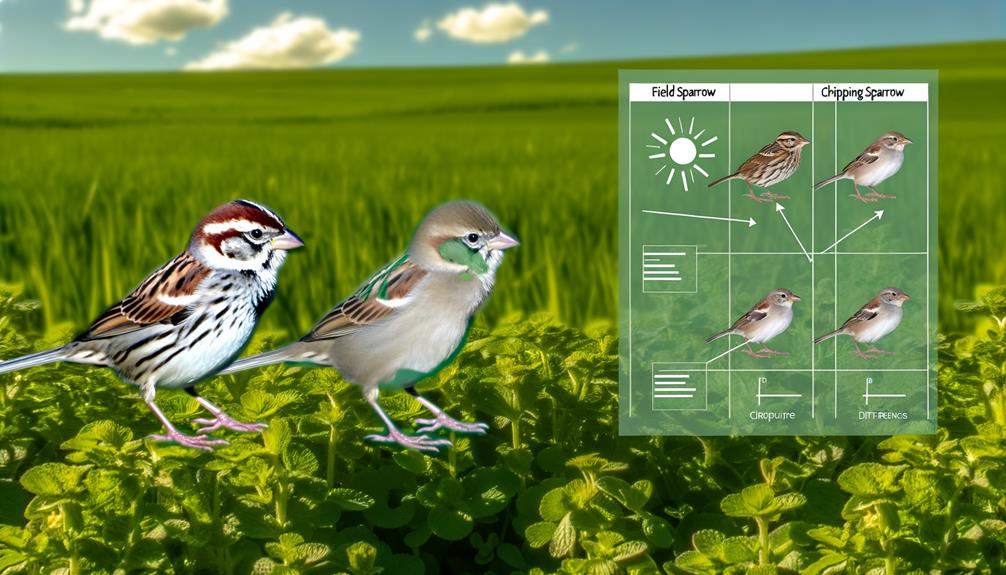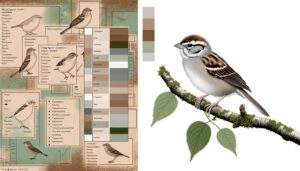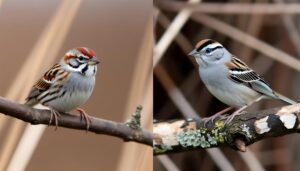10 Key Differences Between Field Sparrow vs Chipping Sparrow
Field and Chipping Sparrows, both natives of North America, exhibit distinct traits and behaviors. Field Sparrows prefer brushy pastures and open fields, using a sweet, accelerating whistle to communicate.
In contrast, Chipping Sparrows favor sparse woodlands and suburban gardens, identified by a sharp 'chip' alarm call. Key differences also include breeding habits, with Field Sparrows nests typically hidden near the ground while Chipping Sparrows build theirs in trees or shrubs.
Uncovering these creatures' unique adaptations provides interesting insights into their survival strategies and could broaden understanding of avian biodiversity. Exploration could lead to more fascinating discoveries.

Key Takeaways
- Field Sparrows are common in the Midwest and South, while Chipping Sparrows are more widespread across North America.
- Field Sparrows prefer shrubby, open fields, while Chipping Sparrows favor woodland edges and gardens.
- Field Sparrows display a distinctive bouncing flight pattern, while Chipping Sparrows hop swiftly into shrubs or trees.
- The Field Sparrow's song is a series of sweet, accelerating whistles, while the Chipping Sparrow's alarm call is a sharp 'chip'.
- Field Sparrows are monogamous with territorial males, while Chipping Sparrows often form loose colonies during breeding.
Overview of Field Sparrow
The Field Sparrow, scientifically known as Spizella pusilla, is a small songbird that dynamically navigates through shrublands and old fields across the eastern and central regions of North America. Its flight pattern is distinctive, often described as a bouncing ball motion that's punctuated by periods of hovering.
This bird's habitat preferences lean towards open, scrubby areas, and it's often found in abandoned farmlands or overgrown pastures. The Field Sparrow's diet mainly consists of insects during the summer months and seeds in the winter, showcasing a seasonal adaptability to food sources.
Their breeding cycle is also remarkable, with two to four broods produced per year, demonstrating a high reproductive capacity. This overview provides a concise snapshot of the Field Sparrow's behavior and lifestyle.
Key Characteristics of Field Sparrow
Sporting a reddish cap and a soft, gray face, the Field Sparrow showcases striking physical attributes, yet it's the bird's unique song, often described as a series of sweet, accelerating whistles, that truly sets it apart.
- Size and Shape: Field Sparrows are small songbirds, typically around 5 inches in length with a slender, round-tipped tail and a conical bill.
- Color Pattern: Mainly light, with a striking rust-colored cap and eyepatch, set against a soft, gray face, and a clear, buffy breast.
- Behavior: These birds often feed on the ground, fluttering their wings while scratching for seeds, and their flight pattern is bouncing, with alternating flaps and pauses.
Through these key characteristics, the Field Sparrow asserts its unique identity within the sparrow family.
Field Sparrow's Typical Habitat
Beyond the unique characteristics that define the Field Sparrow, its choice of habitat further distinguishes it within the sparrow family. Mainly, this bird is found in the eastern and central regions of North America, favoring brushy pastures, shrublands, and abandoned farmlands.
The Field Sparrow's preference for edge habitats – areas where different ecosystems meet – is clear. The bird's fondness for these environments is likely due to the availability of low, dense vegetation for nesting and a rich supply of seeds and insects for sustenance.
Additionally, this bird's preference for open areas with scattered shrubs may be linked to its need for song perches and lookouts to detect predators. This habitat selection, thus, plays a critical role in the Field Sparrow's survival and propagation.
Common Behaviors of Field Sparrow
The Field Sparrow exhibits a distinct set of behaviors that distinguishes it from other bird species. A thorough study of their song patterns, nesting habits, and feeding practices can offer significant insights into their survival strategies and adaptability.
Such an analysis not only provides a deeper understanding of the Field Sparrow but also contributes to broader ornithological studies.
Field Sparrow's Song Patterns
Embracing the early dawn, field sparrows often serenade their surroundings with a distinctive, enchanting song pattern that's become a defining trait of their behavior. This song pattern is a complex, sweet whistle that rises and falls in pitch, and is typically repeated several times.
To better understand the song patterns, consider the following aspects:
- Frequency: Field sparrows usually sing from late spring through early fall, primarily during dawn and dusk.
- Pitch Variation: Their song starts with low notes, increases in pitch, then descends towards the end, creating a melodic cadence.
- Repetition: Each song sequence is repeated multiple times, often for several minutes.
These song patterns aren't just melodious but serve crucial roles in mating rituals and territory establishment.
Nesting Habits Unveiled
Just as distinctive as their song patterns, field sparrows exhibit unique nesting habits that further illuminate their intriguing behavior. Typically, they construct their nests on or near the ground, skillfully hidden amidst a tangle of grasses and shrubs.
The female takes the lead, meticulously weaving together grasses, twigs and other available materials to form a sturdy, cup-shaped shelter. Field sparrows often prefer areas with scattered bushes and trees, providing ample coverage from predators.
Curiously, they've been observed to alter their nesting sites seasonally, likely in response to changing environmental conditions. This adaptability not only demonstrates their resilience but also their complex understanding of their habitat. Their nesting practices, meticulous and adaptive, further underscore the fascinating nature of these birds.
Diet and Feeding Practices
Exploring their environment with precision, field sparrows mostly feed on a diet of seeds and insects, a dietary preference that's dictated by the season and available resources. In the warmer months, these birds rely heavily on protein-rich insects to fuel their energy-intensive breeding and nesting activities.
However, the diet composition of field sparrows changes as per the season, revealing a remarkable adaptability:
- In the fall and winter, they shift towards a mainly seed-based diet.
- When insects are abundant in spring and summer, they become the primary food source.
- During nesting season, field sparrows feed their young almost exclusively on insects for their high protein content.
Understanding these feeding practices provides insight into how the field sparrow survives and thrives in its natural habitat.
Field Sparrow's Breeding Information
Where does the Field Sparrow breed, you might wonder?
This bird species has a specific preference for open, shrubby areas and they're often found breeding across the Eastern and Central parts of North America. Breeding season typically occurs from April through July.
During this period, the male Field Sparrow establishes a territory and attracts a mate through a distinctive, melodious song. The female then constructs a ground or low shrub nest, often hidden among tall grass or small shrubs. She lays, on average, 3 to 5 eggs, which she incubates for about 11 days.
Both parents feed the young, which leave the nest roughly 8-10 days after hatching. It's a fascinating, precise process that showcases the intricacies of avian breeding behavior.
Overview of Chipping Sparrow
In shifting focus to the Chipping Sparrow, it's essential to first understand its defining features and behavioral patterns.
Identification involves discernment of distinct physical attributes, including coloration and size, which set it apart from other species, such as the Field Sparrow.
Behavior, on the other hand, encompasses the bird's unique habits, vocalizations, and responses to its environment, providing vital insights into its survival strategies and adaptations.
Chipping Sparrow Identification
With a distinctive rusty cap and black eye-line, the Chipping Sparrow is easily identifiable, demonstrating a clear example of the striking simplicity found in nature's designs. This small bird, scientifically known as Spizella passerina, is a common sight across North America.
There are key features to look for when identifying a Chipping Sparrow:
- Cap Color: An adult Chipping Sparrow has a rufous or rusty cap during the breeding season.
- Eye Stripe: The prominent black line through the eye is a characteristic feature.
- Underparts: Its underparts are gray to off-white, providing contrast to the overall appearance.
Chipping Sparrow Behavior
How does the Chipping Sparrow behave, you might wonder?
This small, sociable bird exhibits intriguing behaviors. It's known for its active foraging habits, often seen hopping on the ground in search of food.
During mating season, the male Chipping Sparrow's behavior becomes more territorial; he sings persistently to attract a mate and defends his territory fiercely.
Nesting habits are also distinctive. The female is primarily responsible for building the nest, meticulously crafting it with grasses and lining it with fine materials, such as hair.
The Chipping Sparrow's social structure is hierarchical, with older males typically dominating younger ones.
Surprisingly, they're not migratory but rather move to nearby areas in winter. Understanding these behaviors provides valuable insight into this fascinating species.
Identifying Features of Chipping Sparrow
Spotting a Chipping Sparrow isn't too difficult when you're aware of its distinctive features; they're known for their rufous cap, black eye-line, and pale gray underparts. These characteristics are particularly noticeable during the breeding season, making identification easier.
- The rufous cap, a signature of the Chipping Sparrow, contrasts sharply with the bird's gray-brown back and wings.
- The black eye-line, less common among sparrows, acts as a defining facial feature for this species.
- Pale gray underparts provide a stark contrast to the bird's darker upper body, rounding off its unique appearance.
Each feature serves a purpose, either enhancing camouflage or aiding in mate attraction. Understanding these traits not only helps in identification, but also offers insight into the Chipping Sparrow's survival strategies.
Chipping Sparrow's Preferred Habitat
Chipping Sparrows are highly adaptable birds, typically favoring a wide range of habitats including open woodlands, parks, and suburban areas. As edge-dwelling species, they're often found near boundary zones where forest meets field. Preferring regions with sparse ground cover and scattered trees or shrubs, they've adapted well to human-altered landscapes.
Their nesting sites, usually located in shrubs or low trees, often heavily depend on the presence of deciduous trees and conifers. Unlike some species, they're not exclusively rural or urban, showing resilience in a variety of environments. While they can sustain in diverse habitats, they favor areas with a balance of open spaces for foraging and trees for nesting.
This flexible habitat preference allows the Chipping Sparrow to thrive across a large geographical range.
Behavior Patterns of Chipping Sparrow
Exhibiting a range of distinctive behaviors, the Chipping Sparrow spends most of its time foraging on the ground, hopping rather than walking, and swiftly darting into shrubs or low trees when threatened. This behavior pattern reflects its adaptation to an environment where quick escape from predators is essential.
The Chipping Sparrow's foraging technique involves a methodical search, often flipping leaves or small twigs with its beak to uncover seeds and insects.
Its alarm call, a sharp 'chip,' serves as a warning to other sparrows of potential danger.
During rest periods, these sparrows often engage in mutual preening, a social behavior that helps to reinforce flock cohesion.
Chipping Sparrow's Breeding Details
In the domain of reproduction, the Chipping Sparrow's practices offer a fascinating perspective on avian mating habits. This species is monogamous, with pairs forming shortly after males establish territories in the early spring.
The male's courtship display is a simple, repetitive song that serves to attract a mate and defend his territory. Once paired, the female builds a cup-shaped nest in a shrub or tree, using grasses and lined with animal hair. She lays 2-7 eggs, which are blue or greenish-blue, speckled with brown.
Both parents share in incubating the eggs for about 11-14 days, and in feeding the nestlings. After fledging, the young sparrows remain dependent on their parents for a further 3-4 weeks. This parental care underscores the Chipping Sparrow's commitment to the survival of its offspring.
Comparative Analysis: Field Sparrow Vs Chipping Sparrow
Despite their shared sparrow moniker and similarities in appearance, the Field Sparrow and the Chipping Sparrow exhibit distinct differences in their mating patterns, geographical distribution, and behavioral attributes.
The Field Sparrow is known for its monogamous mating pattern, with males fiercely defending their territories. In contrast, the Chipping Sparrow isn't as territorial and often forms loose colonies during breeding.
While both species are found in North America, the Field Sparrow is more common in the Midwest and South, whereas the Chipping Sparrow is widespread across the continent.
Behaviorally, Field Sparrows are more solitary, preferring shrubby, open fields. Chipping Sparrows, on the other hand, are often found in flocks, favoring woodland edges and gardens.
These distinctions highlight the fascinating diversity within the sparrow family, despite their superficial similarities.
Conclusion
In the grand tapestry of nature, the Field Sparrow and Chipping Sparrow paint unique, yet interconnected portraits. Each bird, with its distinctive traits and behaviors, contributes to our world's vibrant biodiversity.
The Field Sparrow's rustic charm contrasts with the Chipping Sparrow's urban adaptability, making for a fascinating study. Their differences, like two sides of the same coin, beautifully highlight the adaptability and resilience of nature's creatures in their chosen habitats.






